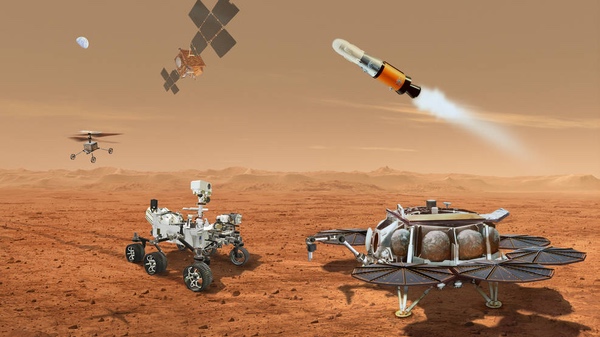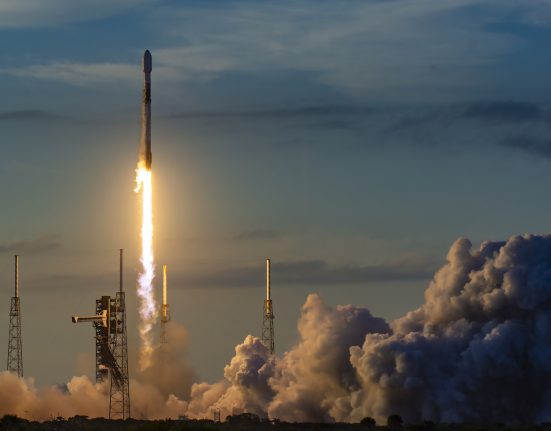 NASA's current architecture for Mars sample return faces cost and schedule pressures, leading some to argue for a radical rethinking of the program. (credit: NASA) |
by Dale Skran
Monday, August 19, 2024
There have been many reports in the news lately about the growth of the Mars Sample Return (MSR) budget in publications such as Science and Space Newswith widespread fear that MSR's growing budget will decimate NASA's other planetary programs, or that MSR will eventually be cancelled and the money transferred to Artemis. This situation has led to a number of re-do's of the MSR architecture, which appear to have done little to reduce costs or create better outcomes. More recently, NASA has initiated a series of layoffs at JPL primarily affecting MSR, apparently in anticipation of significant budget cuts, which has caused further alarm among supporters of space exploration. NASA recently solicited industry input on alternative approaches to MSR under the title “Rapid Mission Design Studies for Mars Sample Return”, selecting several companies in June for short-mission concept studies.
As currently imagined, MSR does little to contribute to long-term Mars exploration, and by consuming a huge amount of budget and energy, it could wreak havoc on the rest of NASA’s robotic exploration program. An obvious alternative is to reimagine MSR as the first step toward landing humans on Mars, rather than as an isolated effort consisting of technology that is unlikely to benefit a human mission to the surface of Mars.
| As currently imagined, MSR does little to advance long-term Mars exploration, and by consuming a huge amount of budget and energy, it arguably wreaks havoc on the rest of NASA's robotic exploration program. |
There is an elephant in the room: SpaceX’s Mars architecture built around Starship/Super Heavy. Despite having partially embraced this approach in the Artemis program for use as a lunar lander, NASA remains mired in “commercial study hell”(1) when it comes to going to Mars. There appears to be a significant tug-of-war between those who insist that a nuclear rocket is required to go to Mars with humans and others, including SpaceX, who favor the use of chemical rockets for in-space resupply. A more recent NASA commercial study(2) concludes that “…the high ∆V required for rapid Mars missions with short dwell times drives the need for nuclear propulsion technology…previous studies have shown that non-nuclear options require extremely aggressive technologies and concepts of operations to close a rapid Mars mission. A comparable all-chemical ConOps is unlikely to be feasible.”
This study recommends chemically powered nuclear-electric propulsion as the preferred solution over thermal nuclear propulsion. They are probably right, but by focusing on short stays on Mars with fast mission profiles, they exclude SpaceX’s Martian architecture from serious consideration, as well as all the technologies like in-situ resource utilization (ISRU) that reduce costs over time and support a sustainable human presence on Mars. NASA has traditionally created disposable, mission-specific, self-limiting, and tailor-made equipment for human exploration. Perhaps it is time for a new approach.
Since NASA has already committed to making Starship/Super Heavy work as a lunar lander, the next logical step would be to build on that experience and repurpose the basic structure for landing on Mars. What better way to test that architecture than by using it for Mars sample return?
So, let’s put on our “visionary” hats and look at what the MSR might look like if it were built around Starship. We would need more tanker flights than for a trip to the Moon, and since a fully refueled Starship has been designed to land on Mars, this seems like a good starting point. The next question is how to get Starship off the surface of Mars and back to Earth. Using ISRU to create fuel on Mars is probably a bridge too far for the near term, so fuel could be prepositioned on Mars to power the return to Earth. Alternatively, refueling could be done in Mars orbit, both before landing and after landing to prepare for departure from Earth. Either approach requires a significant number of fuel tankers headed to Mars, as well as highly reliable and effective cryogenic coolers and transfer/pumping equipment. The last necessary component of the system is a means to collect the samples and place them on the return vehicle.
Here's an opportunity for NASA to shine: multiple helicopters could be used to collect samples and return them to the spacecraft through one large door. This approach avoids the need for ramps, elevators, or hoists. It also creates flexibility, since helicopters could travel a considerable distance to collect samples. Plus, there would need to be multiple helicopters so there would be redundancy.
| This entire program will almost certainly cost more than the $8 billion to $11 billion likely to be spent on the current MSR plan. However, it will also eliminate much of the risk involved in sending humans to Mars. |
In this scenario, fuel tankers are the test flights. They will continue to be sent until there is enough fuel on or around Mars for the return trip. Some of these landings will fail, but success will eventually be achieved. The resulting spacecraft will be able to land reliably on Mars and store fuel for many years – both are key technologies needed to send humans to the Red Planet and return them to Earth. Now comes the moment of truth: the return spacecraft with the samples. Suppose the first one crashes. No harm done – it will be tried again and again, until it succeeds. The samples can return in batches to ensure that at least some of them make it back to Earth.
Return to Earth can be further simplified by skipping the ground landing and replacing it with a docking with a space station in Earth orbit or with the Gateway in a halo orbit around the Moon. Perhaps the safest way to initially quarantine samples would be on a space station, followed by return to Earth on a highly reliable cargo vehicle.
This entire program will almost certainly cost more than the $8 billion to $11 billion likely to be spent on the current MSR plan. However, it will also eliminate much of the risk involved in sending humans to Mars. The remaining components needed to send crews to Mars include the ISRU on Mars to locally produce fuel for the return trip and the environmental control and life support system (ECLSS) to keep astronauts alive on a long trip. With fuel prepositioning on Mars or in Mars orbit and refueling already perfected, fuel production by the ISRU could be skipped on the first crewed trip. These are not small things, but they are incremental to a Starship-based MSR plan. Moreover, the Mars trip’s ECLSS will build on decades of work on the ISS, the ECLSS Gateway system, and the ECLSS built to enable Starship to land crews on the Moon. There is also the possibility that SpaceX could create a long-term ECLSS-capable “space station” version of Starship as a standalone commercial entity.
What is on the table here is the possibility of reducing the overall cost of sending humans to Mars while substantially reducing the risk through extensive testing. The main challenge that this plan will have to overcome is accepting that a significant number of spacecraft will land on Mars, and that some of them will crash. There has been much discussion about what “sterilizing” a spacecraft might entail in order to meet the current super-strict planetary protection standards. Among the many problems is that hundreds of tons of methane fuel would have to be “sterilized,” which strains credulity. A major rethinking of planetary protection will be required for any program to send humans to Mars, but using spacecraft to support MSR would move that debate forward in time.
While there is theoretically some risk of contamination if humans (or spacecraft) land on Mars, it is also possible that we will never find life on Mars on the current schedule of one robot every few years. What may be necessary to find life on Mars is a massive, intensive exploration program involving large amounts of drilling and extensive robotic exploration of hard-to-reach places. Such a program, targeting dozens of locations across Mars, requires hundreds of tons of equipment, regular resupply, and may be best managed from a manned base on Mars.
So let’s deal a new deck of cards, abandon the current MSR architecture, and focus on using Starship. Starship’s ability to land on a large planet has already been demonstrated more extensively (i.e., a Starship has landed on Earth) than any proposed MSR hardware, which exists only in PowerPoint slides. And NASA’s current Artemis plan assumes rapid progress on Starship development, including multiple landings on the Moon.
Note: We are moderating comments. There will be a delay in posting comments and there is no guarantee that all submitted comments will be posted.













Leave feedback about this